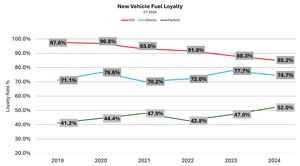ATLANTA, Sept. 6, 2017 /PRNewswire/ -- LexisNexis® Risk Solutions, a unit of RELX Group (NYSE: RELX) and a leader in providing essential information that helps customers across all industries and government assess, predict and manage risk, today released its 2017 LexisNexis® True Cost of FraudSM report. New for 2017, the study has expanded beyond the retail space to explore the impact of fraud on additional key sectors driving of the U.S. economy: e-commerce, financial services and digital lending.
Based on a survey of nearly 1,200 risk and fraud executives across industries, the study is designed to help merchants (retail and online/mobile), financial services companies and lenders grow their business safely even with the growing risk of fraud.
Key to the report is the LexisNexis Fraud MultiplierSM, which estimates the total amount of loss a business incurs, based on chargebacks, fees, interest, merchandise replacement and redistribution. This year, every dollar of fraud to merchants and firms in these sectors is estimated to cost $2.66 on average. For organizations selling digital goods and / or primarily transacting through remote channels, the cost is estimated to be even higher, at $3.48 per dollar of fraud, on average.
The study also investigates fraud costs as a percentage of revenues, as reported by survey respondents, to be nearly 2 percent (1.90 percent) across retail, e-commerce, financial services and digital lending businesses. Businesses that sell digital goods and / or conduct transactions primarily through remote channels take an even harder hit to their bottom line at 2.51 percent of revenues.
"For every $1 of fraud, businesses incur on average $2.66 or roughly two and a half times the actual loss itself. This accounts for nearly two percent of these businesses' annual revenues," said Paul Bjerke, vice president, fraud and identity management strategy, LexisNexis Risk Solutions. "While two percent may not sound significant, the impact can be tremendous when you're talking about a multi-million dollar company. Businesses need to be aware of the issue and proactive measures they can take to protect their bottom lines."
Digital Age Driving Fraud Risks
Along with increased costs, the study found the volume of successful and thwarted fraud continues to climb. This is driven in part by growth among larger multi-channel merchants, including those with digital goods.
Additionally, organizations in the e-commerce and financial services industries generally experience a higher range of fraud costs as a percentage of annual revenues.
"As more transactions move away from the physical point-of-sale and to the digital and mobile spaces, businesses need to account and prepare for the various potential attack points of fraudsters," said Kimberly Sutherland, senior director, fraud and identity management strategy, LexisNexis Risk Solutions. "In their efforts to fight fraud, however, businesses should not overlook the importance of reducing friction in transactions to ensure a smooth end-customer experience."
Mid-to-Large Businesses Struggle Most
Larger digital merchants and firms (those with $50 million or more in annual sales) tend to feel more pain with regard to fraud, with related costs as a percentage of revenues tending to be higher for these businesses.
While larger merchants and firms use an average of 5.5 to 6.4 fraud mitigation solutions compared to the average 2.2 to 3.4 employed by among smaller organizations, use of any one solution type, such as identity authentication, is modest.
"Despite larger merchants and firms generally employing twice as many anti-fraud solutions as smaller organizations, their fraud costs as a percentage of revenue are on par with or higher than smaller organizations across industry segments. And in most cases, they are also experiencing a higher cost for every $1 of fraud. This suggests they aren't using the right combination of anti-fraud solutions," said Bjerke.
While larger merchants and firms often use more fraud mitigation solutions, they may not be doing so optimally given they experience higher fraud volumes and costs.
Despite growing risk, when compared to prior use of fraud solutions used in the retail sector, it appears investment in anti-fraud solutions by businesses has remained flat. "This suggests many businesses are relying on legacy solutions instead of increasing their protection as the risk of fraud increases with the digital age. But organizations need to evolve their anti-fraud strategy and increase or layer protections as new risks are introduced," added Bjerke.
LexisNexis Risk Solutions will make additional industry-specific data available in upcoming reports focused on the retail, e-commerce, financial services and digital lending sectors.
To learn more, please visit: www.lexisnexis.com/risk.
2017 LexisNexis® True Cost of FraudSM Study Methodology
This is the ninth annual comprehensive research study on U.S. merchant fraud conducted by LexisNexis Risk Solutions. This study targeted U.S. retailers with a comprehensive survey of 1,196 risk and fraud executives across retail, eCommerce, financial services and lending organizations and was conducted during March to April 2017. Respondents represented all channels (physical point of transaction, online, mobile), company sizes, and payment methods in order to be consistent with previous study waves. The overall margin of sampling error is +/- 1.45 percent at the 95 percent confidence level. Data reflect the U.S. population for these 4 sectors based on weighting to the U.S. Economic Census.
About LexisNexis Risk Solutions
At LexisNexis Risk Solutions, we believe in the power of data and advanced analytics for better risk management. With over 40 years of expertise, we are the trusted data analytics provider for organizations seeking actionable insights to manage risks and improve results while upholding the highest standards for security and privacy. Headquartered in metro Atlanta, USA, LexisNexis Risk Solutions serves customers in more than 100 countries and is part of RELX Group plc, a global provider of information and analytics for professional and business customers across industries. For more information, please visit www.lexisnexis.com/risk.
SOURCE LexisNexis Risk Solutions
Related Links
WANT YOUR COMPANY'S NEWS FEATURED ON PRNEWSWIRE.COM?
Newsrooms &
Influencers
Digital Media
Outlets
Journalists
Opted In





Share this article